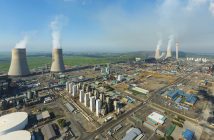As the Green Building Council South Africa (GBCSA) celebrates 10 years of inspiring better buildings, celebrated with a commemorative coffee table book, we ask the question whether the building industry in South Africa has benefitted from such a non-profit institution. While the underlying mission of the GBCSA shows good intent and there is a definite need to promote the benefits of green buildings in South Africa, has the public at large been convince of their rating tool model which has been imported from Australia?
There are many building rating tools around the world. The most successful tools are the ones that have been home grown, initiated by governments and developed by patriotic minds that are equally passionate about buildings as they are the environment. For example, BREEAM in the UK, mandated by the UK government and introduced in the United Kingdom in 1990, it is the most established green building rating system in the world with over 100000 building certifications issued.
Let us look back. Ten years ago, the South African building industry found itself way behind the global green building movement. Various local built environment organisations committed to tackling climate change, headed by Mr Bruce Kerswill, MD of Spire Property Group, found that the Australian system was the most relevant for the South African environment. They approached the Australians who agreed to a licence their model to the newly formed Green Building Council of South Africa.
Whilst the underlying intension was noble, it appears that there was no attempt made to form a home grown, ‘South African’ Green Building Council by engaging with local industry players, academics and government at the time. The ‘copy and paste’ move was seen by many as a quick fix solution. There is also the perception that no attempt was made to identify other international trends and commonalities regarding rating tools in order to gain a perspective on ‘what works’. Against this background, it is easier to understand the question marks around credibility and ongoing scepticism by the public at large as to what value the GBCSA brings to the building industry, the country and most importantly, to our environment. The GBCSA responds that the model was not copied from the Australian system – it has been carefully modified to pertain specifically to the South African market through Local Context Reports and input from all sectors of the industry.
A quick snapshot of the staff profile; we find the GBCSA is a paltry Level 8 B-BBEE contributor. Employment profile is 17 females, 9 males; 17 white, 5 black and 4 coloured. The point made here is why are there no young black engineers/green building professionals in leadership roles at the council? Surely a more representative local staff compliment would be better placed in creating a truly home grown rating system? The GBCSA claim that at EXCO level, of the five members, three are black South Africans.
The flagship rating tool is the Green Star SA new building tool ‘by design’ or ‘as built’, which can be argued to have evolved over time to present itself to be ‘South African’. The general rating tool offering has expanded to include a broader profile which includes office, retail, multi-unit residential, public and education buildings, as well as others like interiors and existing buildings performance. There is also a very exciting Socio-economic category that was recently launched. The tools are of an international standard and provide an excellent measure against agreed standards and benchmarks. But are they really applicable to implement in the South African context? For example the allocation of points for electric/hybrid car parking bays and bicycle sheds. It is here where an Australian formulated tool is not relevant in South Africa. Unlike Australia, hybrid and electric cars are not subsidised by government in South Africa and such cars are not common place due to their high cost. We do not have established cycling schedules and the security issues associated with cycling to work have not been taken into account. As a result credit is given for these features but their practicality an implementation in the South African context is questioned. These are just two of many examples. The GBCSA points out that Green Building rating tools are designed to transform the industry, and so reward practices that change the norm – i.e. where there were no cycle paths previously, there are now cycle paths emerging. Green Star is playing a role in changing these behaviours.
There is also a fundamental flaw in offering two forms of rating tools namely; by ‘design’ and ‘as built’. Design certification is awarded at the end of the design phase of a project so that a building can be marketed as Green Star SA certified. When construction is complete, the project may be submitted for ‘As Built’ certification which verifies the procurement and implementation of green building strategies. This poses questions regarding performance. How does intended performance as rated by design compare with actual performance ‘as built’ and more importantly, as occupied and in use for the life of the building? Enter an additional rating tool called The Green Star SA – Existing Building Performance Tool. This covers the same environmental categories addressed in the Green Star SA new building tools (Design / As Built) but the focus is on the efficient operations and management of the building in order to maintain optimal performance. Against this background, it is then not surprising that 74% of the 161 buildings that have Green Star accreditation in South Africa are by ‘design’. It appears to be the shortest, cost effective route to market your building as Green Star Certified with the general public none the wiser as to what specific accreditation the building has achieved or how it performs.
The irony is performance measurement can easily be done through real time monitoring with the aid of a complete building management system installed or specified by GBCSA as part of the rating tool condition. It can also be extended to building life cycle performance measurement to really determine the long term effect of the rating tool and its impact on the environment. One single rating tool incorporating ‘design’, ‘as built’ and ‘performance’ will go a long way in making the GBCSA a truly credible institution. Having three separate rating tools for a single building raises questions whether the GBCSA is in it for the money or the cause?
There are other possible improvements the GBCSA may consider to gain more credibility. The following points are raised and accordingly replied to by the GBCSA in italics:
- Introducing a rating tool for Existing Building Retrofit in addition to Existing Building Performance Rating tool. The new build tools are also for existing buildings that undergo major refurbishments. Projects that targeted this are for example Millenia Park and Menlyn Shopping Centre Refurbishment.
- Measurement and recording of rated buildings’ carbon emissions through tracking and reporting. A building’s operational phase accounts for 80-90% of emissions resulting from energy use mainly for heating, cooling, ventilation, water heating, lighting and office equipment/computers. This is done through the Green Star – Existing Building Performance tool and Energy Water Performance. Q: Is this data available to the public?
- Rating criteria for deconstruction or disassembly including relocation of built structures. This is a credit on the Green Star new build tools.
- Ongoing measurement and recording of indoor air quality.
- Introduce independent, third party auditing and authentication after the completion of construction, while the building is inhabited and in use. This is part of the Green Star – Existing Building Performance tool. Q: Who is appointed and is the data available to the public on such audits?
- Introduce more importance (allocate more points) for building emergency management systems as part of the overall building management rating. Emergency management planning and procedure plays a major role in building performance and may prevent the necessity of rebuilding. The criteria can extend to mitigation of building hijacking, a common problem in most South African cities.
- Rating criteria for mixed use buildings or complexes which also seeks to address the social and economic challenges that South Africa faces, like bringing workers closer to the work place. This broadens the GBCSA’s scope to integrate with sustainable urban development. There is an option for custom mixed use certification for new buildings or major refurbs, and also through the Green Star – Sustainable Precincts tool .
- Loose the Australian ‘tag’ by disengaging from the licence agreement. No offence to the Green Building Council of Australia. Their model is very effective and successful in Australia.
International trends reveal that building industry stakeholders are pealing back the layers regarding actual performance of green star rated buildings, many years after occupation. One such case in the United Sates involved a US6 Million lawsuit filed by the designers of the first LEED Platinum rated building against a company that oversaw the construction. The beef in this case was over the supply of certain untried materials and their subsequent need for a coating treatment. To date, there have been no lawsuits against the GBCSA or between contractors responsible for the construction of a GBCSA rated building. No doubt there may be one in the future. Still under licence from the Green Building Council of Australia, it will be interesting to see whether the Australian Council will be implicated if a lawsuit is filed in South Africa against the GBCSA.
Buildings are responsible for approximately 33% of all global emissions, accounting for well over 10 billion metric tons of CO2 emissions. As such the GBCSA mandate is very serious. Have they come of age in fulfilling their serious mandate? No doubt, their commemorative coffee table book will tell you they have.
Author: Bryan Groenendaal
About the author: Bryan is an accredited Green Star Professional through the GBCSA. He has a Master’s degree in Sustainable Urban Development from Bond University, Australia where he completed a first class thesis on how to improve green building rating tools.











